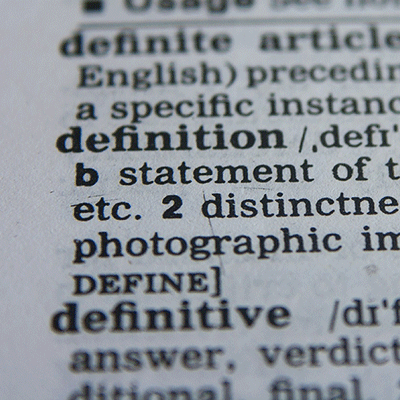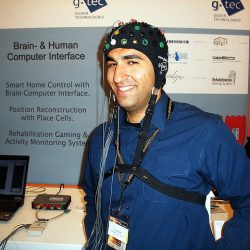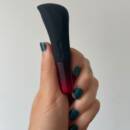What Is the Origin and Definition of Teledildonics?
Getting to the bottom of one sexy neologism.

If you’re interested in sex toys and the Internet, chances are you’re familiar with the word teledildonics. This mouthful of a term refers to technology that sends and receives sexual touch over data networks.
Teledildonics definition
A broader definition of teledildonics or teledildonic devices is that they are electronic sex toys operated with computers or devices that use data. They transmit sensations through touch sensors to help long-distance partners arouse each other in real time.
For example, sex tech companies Lovense and Kiiroo sell interactive sex sleeves and dildos. Pair two or more with an Internet connection, and then you can feel your lover’s intimate movements from miles away. But it could go much further than that. In the next few decades, haptic body suits could make full-body, long-distance sex fully plausible.
What’s perhaps less clear is the origin of the word teledildonics—at least online. (Word geeks, stay with me here!)
After doing a Google search, you’ll find most sources claim tech pioneer Ted Nelson coined the term in his 1970s book Computer Lib/Dream Machines. But while Nelson did play a role, he didn’t create the word all on his own.
The origin of ‘dildonics’
If you read Computer Lib/Dream Machines, which is freely available on Scribd (albeit in poor quality), you won’t find “teledildonics.” Instead, the phrase “Pyscho-Acoustic Dildonics” appears on page DM9. It refers to a device invented by How Wachspress, which turns audio signals into pressure felt by the body.
Wachspress’s machine, patented in 1973, is named the Audiotactile stimulation and communications system in its filing documents. Elsewhere, it’s been called the Sonic Stimulator or Sonic Dildo.
Nelson describes it in his book:
“The sensations, it is claimed, are profound and moving. You may take them anywhere on your body: the effect is deeply relaxing and emotionally engrossing. Wachspress thinks he has reached an entire neurological system that wasn’t known before, much like Olds’ discovery of the ‘pleasure center’ in the brain: he sees it as a new modality of experience and a generalization of music and touch.”
Alas, in Nelson’s CV he takes credit for coining “dildonics” in 1974, the same year Computer Lib/Dream Machines was first published.
Placing the prefix
The creation of the word “dildonics” revved up people’s imaginations, particularly that of Howard Rheingold, a tech theorist who invented the phrase “virtual community.”
In his 1990 essay “Teledildonics: Reach Out and Touch Someone,” Rheingold pays homage to Nelson’s neologism. Versions of the essay can be found in Rheingold’s 1991 book Virtual Reality and the 2004 compilation Net.SeXXX: Readings on Sex, Pornography, and the Internet.
He wrote:
“Dildonics—it had to happen. It is the unnatural fruit of the marriage of lust and craft. The word ‘dildonics’ was coined by visionary computer pontiff Ted Nelson in 1974. Ted is best known as the inventor of hypertext and designer of the world’s oldest unfinished software project, appropriately named ‘Xanadau.’”
In that same essay, Rheingold added the famed “tele” prefix, while giving a fascinating prediction of long-distance sex made possible with mobile devices he calls “telediddlers.”
His visions of future sex evoke a sense of being before their time, even foretelling a world where virtual reality merges with remote sex—a pairing that 26 years later is still only in the fledgling prototype phase.
Below is his first mention of “teledildonics:”
“The first fully functional teledildonics system will probably not be a fucking machine. You will not use erotic telepresence technology in order to have sex with machines. Twenty years from now, when portable telediddlers are ubiquitous, people will use them to have sexual experiences with other people, at a distance, in combinations and configurations undreamt of by precybernetic voluptuaries. Through the synthesis of virtual reality technology and telecommunication networks, you will be able to reach out and touch someone—or an entire population—in ways humans have never experienced before.”
Rheingold told Future of Sex he believes he’s responsible for the word’s coinage.
However, while he’s also received credit from others, his part seems to largely be overshadowed and wrongly attributed to Nelson.
What’s next?
At the end of the day, it’s not necessarily important who coined what per se, but where the actual technology is going. Yet it’s still interesting to explore the birth and morphing of terms.
Not everyone is in love with the word teledildonics. Sex tech consultant Lux Apltraum called it dated, and I dare say seemed to cringe at the word, during a podcast with The Verge’s Christopher Plante. (It’s a great one on virtual sex: listen here.)
Technically, “teledildonics” is dated, but it’s still commonly picked up by larger media outlets. Apltraum prefers the current term used within the industry—haptic sex— with haptic referring to the sense of touch.
It certainly rolls off the tongue easier than its five-syllable predecessor.
Image source: PDPics
Leave a reply
You must be logged in to post a comment.

















